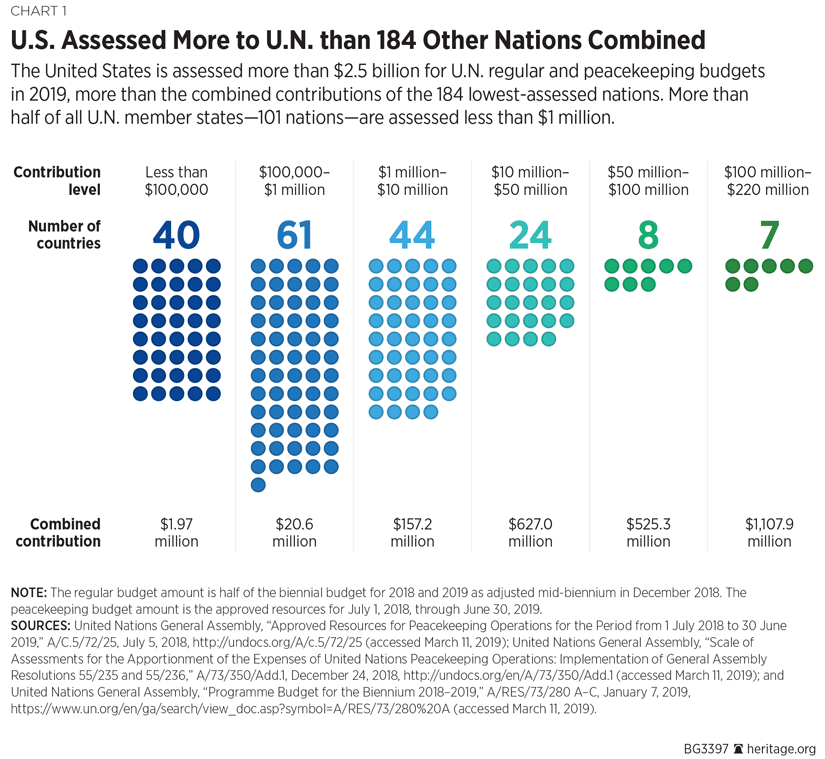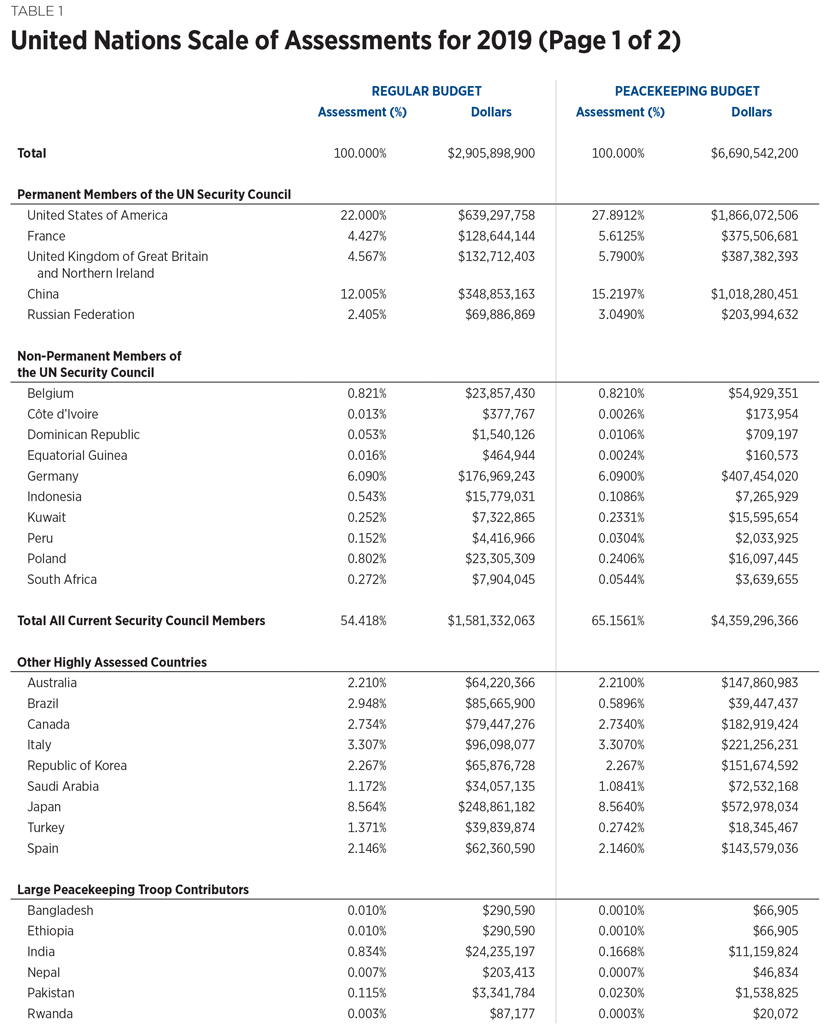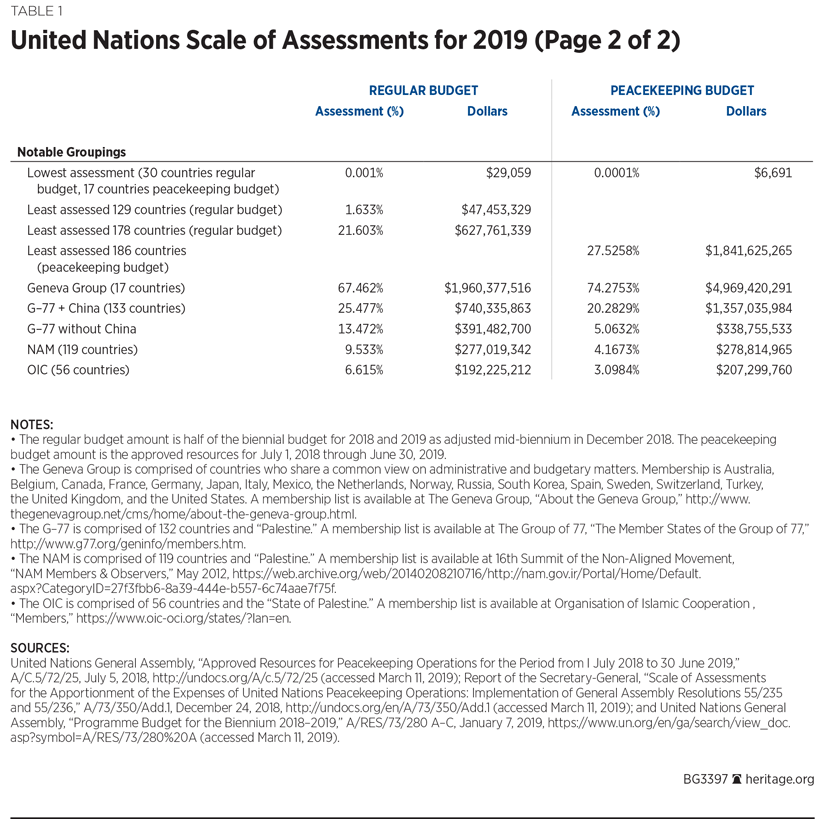Every three years, the United Nations General Assembly adopts a new “scale of assessments” under which the U.N. assigns specific percentages to the member states, which they are expected to pay to support U.N. expenses, programs, and activities. Since the first scale in 1946, the United States has objected to the U.N. relying excessively on a single member state for the budget—which has always been the U.S.—and argued for establishing a maximum assessment level and, subsequently, lowering that maximum.
In 2017, President Donald Trump echoed that message, arguing that “no nation should have to bear a disproportionate share of the burden, militarily or financially.”REF The Trump Administration is correct to call for changes. This year, the U.S. alone is assessed more for the U.N. regular and peacekeeping budgets than 184 U.N. member states combined. (The total number of U.N. member states is 193.) This disequilibrium undermines the incentive of many countries to fulfill their oversight role and seriously consider budgetary restraint because they have little financial skin in the game.
Over the past year, the U.S. proposed numerous changes to distribute the costs of the U.N. more equitably. Yet, limited time and inconsistency undermined the effort, and the General Assembly adopted the scale of assessments for 2019 to 2021 this past December without any methodological changes. To avoid a similar outcome for the next assessment in 2021, the U.S. should:
- Increase diplomatic efforts to adjust the U.N. scale of assessment. The current scale of assessments does not expire until 2021, but convincing member states to assume a greater financial burden requires sustained diplomatic effort over the next three years. For most countries, foreign ministers or heads of government will make compromises and final decisions. Discussions must start and continue in New York, but success will require support from U.S. ambassadors to individual countries and occasional intervention by the Secretary of State and the White House.
- Enforce the 25 percent cap on America’s peacekeeping assessment. As it did in the 1990s, the U.S. should use its financial leverage and withhold the difference between its peacekeeping assessment and the 25 percent cap enacted under U.S. law until the U.N. implements a maximum peacekeeping assessment of 25 percent. The U.S. should pay these arrears only after the U.N. incorporates a maximum assessment of 25 percent in the methodology for calculating the peacekeeping scales of assessment.
- Seek changes that give more influence on U.N. budgetary decisions to major contributors. The U.S. should propose a rules change to require that, in addition to approval by two-thirds of the member states, U.N. budgetary decisions must be approved by member states collectively paying two-thirds of the regular budget assessments. Improved governance and accountability requires that the U.N. take more than capacity to pay into account when approving the scale of assessment.
History of the Scale of Assessments
The United Nations Charter does not specify a method for paying for the expenses of the organization, despite the fact that the U.S. was concerned about shouldering an excessive portion of the funding even in the early negotiations to establish the U.N.REF The U.N. Charter, completed at the 1945 San Francisco conference, references budgetary procedures only in Articles 17, 18, and 19.
- Article 17 states that: “The General Assembly shall consider and approve the budget of the Organization” and that the “expenses of the Organization shall be borne by the Members as apportioned by the General Assembly.”
- Article 18 states that each member state has one vote and that important matters, including budgetary questions, require approval “by a two-thirds majority of the members present and voting.”
- Article 19 stipulates that any member state “in arrears in the payment of its financial contributions to the Organization shall have no vote in the General Assembly if the amount of its arrears equals or exceeds the amount of the contributions due from it for the preceding two full years” unless the General Assembly “is satisfied that the failure to pay is due to conditions beyond the control of the Member.”REF
The lack of detail on financial contributions was deliberate. In the words of the Venezuelan delegate to the San Francisco conference, how the U.N. should be funded was “one of the most delicate and debated questions” and was avoided out of concern that it could undermine the delicate negotiations underway.REF Avoiding the issue facilitated the negotiations in San Francisco, but also laid the groundwork for repeated budgetary clashes over the next 60 years.
Since the U.N.’s establishment, its member states agreed to apportion the expenses of the U.N. “broadly according to capacity to pay.”REF This means that wealthier nations, based principally on per capita income, pay larger shares of the budget than poorer nations. However, as evidenced by their actions in establishing a minimum assessment of 0.04 percent in 1946, they did not believe that membership should be costless or insignificant, even though the original member states included extremely poor countries, such as Haiti.REF
The United States has been the U.N.’s largest financial supporter ever since the organization’s founding and was assessed 39.89 percent in the first scale adopted in 1946.REF However, even in 1946, the U.S. strongly objected to paying more than 25 percent of the expenses of the U.N. and sought consistently in subsequent decades to reduce the U.S. assessment further.REF
U.N. Regular Budget Scale of Assessments
The current scale of assessments for the U.N. regular budget, which covers the expenses of the Secretariat, the General Assembly, and other U.N. bodies, uses the methodology agreed to in 2001.REF The calculation of assessments starts with a country’s gross national income (GNI) converted into U.S. dollars according to market exchange rates.
For countries under a specified income threshold, the U.N. adjusts the income data downward by 12.5 percent of the country’s debt burden (the theoretical debt-service ratio). In addition, countries with low per capita incomes, defined as under the world average for the period, have their incomes further reduced by 80 percent of the difference between a country’s per capita GNI (PCGNI) and the world average. The methodology distributes the cost of the debt and low per capita income adjustments on a proportional basis among the member states that do not qualify for those reductions.
Finally, the scale incorporates a maximum assessment of 0.01 percent for “least developed countries” and, for all countries, a minimum assessment of 0.001 percent and a maximum assessment of 22 percent. The methodology distributes the cost of these minimum and maximum assessments on a proportional basis among the member states that do not qualify for those adjustments. The resulting adjusted income over two periods (the preceding six years and preceding three years) is used to derive the final assessments.REF
All told, approximately two-thirds of the 193 U.N. member states receive some sort of reduction to their regular budget assessment through various adjustments—in other words, their assessment is less than their share of world GNI.REF
U.N. Peacekeeping Budget Scale of Assessments
The current scale of assessments for the U.N. peacekeeping budget uses the methodology agreed to in 2001. Under this methodology, the peacekeeping assessment rate uses the regular budget as its starting point and divides the U.N. member states into 10 levels based on (1) permanent membership on the Security Council and (2) their PCGNI.REF
- Permanent members of the Security Council, placed in “Level A,” are assessed at a higher rate than their regular budget assessments. This surcharge, called a “premium,” is the total amount of the peacekeeping discounts awarded to other member states in Levels C through J and is distributed on a pro rata basis among the five permanent members.
- Most countries with a PCGNI higher than twice the average for all U.N. member states are placed in “Level B” and receive no discount off their regular budget assessment, that is, they are assessed the same percentage for the regular budget and the peacekeeping budget.
- A small number of countries—currently Brunei Darussalam, Kuwait, Qatar, Singapore, and the United Arab Emirates in the 2019–2021 scale of assessments—with a PCGNI above twice the world average are placed in “Level C” and receive a 7.5 percent discount. This discount is awarded because they are members of the Group of 77 and are considered “developing countries” even though their PCGNIs are higher than many of the countries in “Level B.”
- All countries at or below twice the average world PCGNI are placed in “Level D” through “Level I” and receive discounts between 20 percent and 80 percent off their regular budget assessment. The discounts increase as PCGNI falls below specified thresholds.
- Finally, all countries considered “least developed countries” are in “Level J” and receive a discount of 90 percent off their regular budget assessment.
Over 80 percent of all U.N. member states receive some sort of discount on their peacekeeping assessment. These discounts apply in addition to any regular budget discounts they received. To implement these discounts, the General Assembly lowered the minimum assessment for peacekeeping to 0.0001 percent compared to the 0.001 percent minimum for the regular budget. Overall, discounts applied for the peacekeeping scale of assessments totaled 12.1583 percentage points in 2019 ($813.5 million under the current peacekeeping budget),REF which the permanent members of the Security Council shoulder as the premium surcharge.REF
Disparities in U.N. Assessments
The primary result of assessment adjustments has been to shift the costs of the organization away from the bulk of the membership onto a relative handful of high-income nations. The U.S. is the highest assessed country and is charged 22 percent of the U.N. regular budget and 27.8912 percent of the peacekeeping budget in 2019. In dollar terms, this equates to $639 million for the amended 2018–2019 U.N. regular budget and $1.866 billion for the current U.N. peacekeeping budget. As illustrated in Table 1, for the regular budget, the U.S. is assessed more than 178 other U.N. member states combined, and 22,000 times more than the 30 countries assessed the minimum level of 0.001 percent. These differences are even starker in dollar terms:
- The 30 countries charged the minimum assessment of 0.001 percent each will pay only $29,059 in 2019 based on the 2018–2019 biennial regular budget as amended in December 2018.REF
- For the peacekeeping budget, the U.S. is assessed more than 186 countries combined and over 278,000 times more than the 17 countries assessed the minimum level.
- The 17 countries charged the minimum peacekeeping assessment of 0.0001 percent in 2019 are each assessed $6,691.
In other words, the least-assessed countries are charged less than $36,000 each in 2019. As observed by a former president and CEO of the United Nations Association of the USA, “Surely it should not cost a nation less to belong to the UN than an individual to go to college or to buy a car.”REF Meanwhile, the U.S. assessment is over $2.5 billion this year for the U.N. regular and peacekeeping budgets—more than the combined assessments of 184 nations in dollar terms.

Currently, over half of the U.N. member states are assessed less than $1 million per year for the U.N. regular and peacekeeping budgets combined. This helps explain why so many member states are blasé about increases in the U.N. budget: The financial impact of budget increases on them is minimal and undermines incentives for them to fulfill their oversight role and seriously consider budgetary restraint.
Recommendations
Vast differences between the amounts that different member states are charged for the expenses of the U.N.—with some countries paying less than $36,000 per year, while a handful of others pay half a billion dollars or more—have undermined the incentive of many governments to fulfill their oversight role and take budgetary restraint seriously. Improved governance and accountability requires that the U.N. take more than capacity to pay into account when approving the scale of assessment. To address these concerns, the U.S. should:
- Increase diplomatic efforts to adjust the U.N. scale of assessment. Unless a stronger relationship between budget decisions and financial contributions is achieved, the U.S. and a few like-minded countries will remain lonely voices calling for budgetary restraint. Over the past year, the U.S. was unsuccessful in trying to persuade other countries to adopt changes to the scale of assessments. The General Assembly adopted the 2019–2021 scale of assessments in December with no methodological changes. The current scale of assessments does not expire until 2021, but convincing member states to assume a greater financial burden requires sustained diplomatic effort. For most countries, foreign ministers or heads of government will make compromises and final decisions. Discussions must start and continue in New York, but success will require support from U.S. ambassadors to individual countries and occasional intervention by the Secretary of State and the White House.
- Enforce the 25 percent cap on America’s peacekeeping assessment. Nearly 20 years ago, Ambassador Richard Holbrooke testified to the Senate that he had secured a deal that would gradually lower the U.S. peacekeeping assessment to 25 percent as required under U.S. law and as a condition for payment of U.S. arrears under the Helms–Biden agreement.REF In good faith, the U.S. paid the arrears that had accrued in expectation that the U.S. peacekeeping assessment would fall to 25 percent. Unfortunately, the U.S. assessment has never fallen to 25 percent. As occurred in the 1990s, the U.S. should use its financial leverage and withhold the difference between its peacekeeping assessment and the 25 percent cap enacted under U.S. law until the U.N. implements a maximum peacekeeping assessment of 25 percent. To avoid a repetition of the Helms–Biden disappointment, the U.S. should pay these arrears only after the U.N. incorporates a maximum assessment of 25 percent in the methodology for calculating the peacekeeping scales of assessment.
- Seek changes to give more influence on U.N. budgetary decisions to major contributors. Together, the top 18 contributors (those assessed more than 1 percent of the U.N. regular budget) are assessed more than 82 percent of the U.N. regular budget. However, under U.N. rules, the 129 member states that contribute just 1.633 percent can pass the budget over the objections of the top 18. The U.S. should seek a rules change to require that, in addition to approval by two-thirds of the member states, U.N. budgetary decisions must be approved by member states who collectively pay two-thirds of the regular budget assessments.
Conclusion
Since the first scale of assessments in 1946, the U.S. has objected to relying excessively on a single member state for the budget, and has argued for a maximum assessment level and, subsequently, lowering that maximum. The historical struggle of the U.S. to constrain growth in U.N. budgets and focus resources on high-priority, effective activities—instead of outdated, duplicative, or unproductive activities—illustrates the wisdom of this stance. In 2001, the U.S. succeeded through use of financial withholding and intense diplomatic effort to get the U.N. to adopt a maximum assessment of 22 percent for the U.N. regular budget. Unfortunately, the U.S. was not able to get the U.N. member states to agree to a maximum peacekeeping assessment of 25 percent, and the U.S. assessment did not fall to that level as projected by Ambassador Holbrooke in 2001. Two decades later, it is time for the U.S. to address this matter.
The U.N. would be healthier, and more member states would have an incentive to scrutinize the budget to maximize efficiency and focus resources on priorities, if the costs were more equitably distributed. However, Washington is only one vote among 193 member states, and success will require congressional resolve and sustained diplomatic effort by the Administration led by the U.S. Mission in New York, and supported by diplomatic engagement from the State Department and the White House.
—Brett D. Schaefer is the Jay Kingham Senior Research Fellow in International Regulatory Affairs in the Margaret Thatcher Center for Freedom, of the Kathryn and Shelby Cullom Davis Institute for National Security and Foreign Policy, at The Heritage Foundation.




